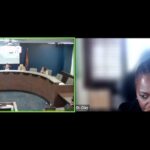Arizona Teacher Misconduct: An Examination of Legal and Ethical Implications
The recent arrest of an Arizona teacher in Utah has sparked a heated debate among educators, legal experts, and community members alike. In a case loaded with tension and tricky parts, Derek Thomas Lange, a 34-year-old high school teacher from Colorado City, was apprehended during a police sting operation in Cedar City. Authorities charged him with attempted rape of a child, enticing a minor, and dealing in harmful materials to a minor. This opinion editorial takes a closer look at the unfolding incident, the legal twists and turns, and the overall impact on the educational landscape and community trust.
The incident began when law enforcement initiated an undercover operation online by posing as a 13-year-old girl. Over a series of conversations on dating websites, Lange increasingly pushed the interactions toward a sexual meetup. With his explicit pictures and overt messages, the teacher’s conduct crossed multiple legal lines. Once authorities zeroed in on his location, he proceeded to arrange a meeting, only to be arrested upon arrival. This case not only raises questions about legal accountability but also brings to light several ethical and societal issues that merit a deep dive into the subject matter.
Background and Context of the Incident
It is essential to understand the context surrounding this case as it ties together several elements of law enforcement, online communications, and education ethics. The teacher, who is employed at El Capitan High School as both an English teacher and a sports coach, was caught in a sting that has echoed through the corridors of educational institutions across multiple states.
This incident reminds us that the digital age has blurred the lines between professional conduct and personal privacy. With the ease of communication provided by social networking and dating platforms, teachers and other authority figures must be extremely cautious. In this case, what began as a conversation on a dating website evolved into a nerve-racking encounter involving explicit digital exchanges and a plan for an in-person meeting. The episode is emblematic of broader trends where technology, ethics, and law intersect in complicated pieces that require transparency and strict legal scrutiny.
Online Predator Sting Operations: A Case Analysis
An undercover operation of this nature naturally prompts several questions regarding how such carefully crafted sting operations are planned and executed by law enforcement. While the stakes are undeniably high in these operations, they are also designed to protect minors from predators who exploit online anonymity.
Below is a table summarizing some of the key components typically involved in these operations:
| Component | Description | Key Considerations |
|---|---|---|
| Online Persona | Police officers create a false identity (usually a minor) to lure potential offenders. | Ensuring the persona is convincing while maintaining strict legal boundaries. |
| Communication Channels | Utilization of dating and social websites to engage in conversations. | Monitoring digital footprints without infringing on privacy rights. |
| Evidence Collection | Recording and saving all digital interactions as evidence. | Maintaining the chain of custody and adherence to legal standards. |
| Arrest Execution | An officer meets the suspect at a predetermined location. | Balancing public safety with the suspect’s legal rights. |
Legal Conundrums and the Path to Accountability
The charges brought against Lange emphasize a series of legal twists and turns that underline how police and prosecutors approach cases involving potential exploitation of minors. The charges include a first-degree felony for attempted rape of a child, a second-degree felony for enticing a minor, and several third-degree felony counts for dealing in harmful materials to a minor.
These allegations, if proven, not only threaten the teacher’s career but also could result in severe penalties including long-term imprisonment. Here, the legal system is trying to twine together various pieces of evidence—from digital messages and explicit images to witness testimonies about his actions on the day of the sting—to form a cohesive case. In such convoluted legal situations, every detail can be described as a fine point that may influence the outcome of a trial.
Understanding the Charges
Let’s break down the charges faced by Lange:
- Attempted Rape of a Child: A first-degree felony that involves any act where an adult attempts sexual contact with a minor. This charge represents one of the most severe accusations in the case.
- Enticing a Minor: A second-degree felony, this charge centers on the actions used to lure a minor into engaging in inappropriate conversations or meetings, particularly in an online environment.
- Dealing in Harmful Materials to a Minor: Charged on four separate counts as a third-degree felony, this relates to the distribution of explicit digital content that can be classified as harmful in nature.
Each of these charges carries its own legal weight and potential sentence. The combination of these multiple charges can be overwhelming for the accused and impactful on public opinion.
Impact on the Educational Environment and Community Standards
This case has reverberated across school districts and community boards as people work through the tangled issues of trust and responsibility. Educators, administrators, and parents alike are now faced with the daunting task of ensuring that such incidents never repeat themselves. Essentially, the community must now figure a path between upholding lawful behavior and maintaining the integrity of educational institutions.
The arrest of a high school teacher who held multiple roles—both as an educator and coach—has led to a reexamination of what it means to maintain professional boundaries in school settings. It casts a shadow over the trust that students, parents, and fellow teachers place in their mentors. The incident forces us to navigate small but important differences between professional and personal online interactions. The case serves as a wake-up call to school administrations to reinforce clear interactions policies and educate staff on appropriate digital conduct.
Community Response and the Role of Educational Institutions
Following the incident, community leaders and school officials have taken various steps to communicate with parents and the public. Below are some common action points implemented by schools in response to incidents like these:
- Revised Staff Policies and Protocols: Strengthening guidelines on digital behavior and establishing strict boundaries for teacher-student online communication.
- Enhanced Training Programs: Offering workshops and seminars on digital ethics and legal responsibilities for educators.
- Transparent Communication: Engaging with parents through meetings and open channels to reassure them of their child’s safety and the school’s commitment to ethical standards.
- Increased Security Measures: Implementing stronger IT security protocols to monitor and prevent misuse of digital platforms within school environments.
These measures, while not foolproof, aim to reinforce a culture of accountability and help restore confidence among stakeholders. Developing such a proactive approach is super important at a time when the online space is as unpredictable as it is ubiquitous.
Online Interactions and the Legal Challenges in the Digital Age
The incident involving Lange highlights challenges tied to the online world, from verifying identity to ensuring the safety of digital communication. As technology advances, the police and courts are often forced to work through complicated pieces that mix digital evidence with traditional legal procedures.
Modern sting operations resemble carefully choreographed performances, relying on the covert collection of digital communications. These cases remind us that the hidden complexities of online interactions are not solely the realm of tech experts but also represent key legal battlegrounds where the safety of minors is at stake.
Protecting Minors Through Stringent Legal Measures
Protecting minors in today’s online environment involves a multi-pronged approach that includes not only law enforcement but also policy makers, educators, and community organizations. Here are some strategic points to consider:
- Clear Reporting Mechanisms: Establishing and promoting channels for reporting suspicious online behavior.
- Improved Digital Literacy: Educating both children and adults regarding the safe use of social media and dating sites.
- Collaboration Between Agencies: Ensuring coordinated efforts between local, state, and federal law enforcement units when managing these cases.
- Regular Policy Updates: Keeping legal frameworks up-to-date with the rapid evolution of technology and communication channels.
This multifaceted approach to online safety is exactly what communities need to get around the challenges presented by digital communication. Every party involved in the protection of minors plays a key role in creating an environment where virtual interactions do not become a gateway to harmful conduct.
Legal Ethics and Professional Responsibility in Education
The case not only emphasizes legal concerns but shines a light on the ethical responsibilities that come with positions of authority in education. Teachers are expected to serve as role models whose personal behavior strongly impacts community standards and the development of young minds.
When a teacher crosses professional boundaries, particularly in online settings, the repercussions extend far beyond criminal charges. There is an ethical dimension that involves betrayal of trust, misappropriation of power, and the risk of causing long-lasting harm to the students affected. Even though this case is currently loaded with legal procedures, the ethical implications are clear and demand a conversation among educators and legal experts alike.
Balancing Professional Duties With Online Freedoms
While the internet offers unprecedented opportunities for professional development and innovation, it also demands that educators make sound decisions when interacting online. Some key areas of focus include:
- Maintaining Professional Distance: Clear separation between personal and professional digital platforms to prevent misunderstandings.
- Understanding Digital Footprints: Recognizing that any online interaction can be recorded and potentially used as evidence in legal proceedings.
- Regular Self-Audits: Encouraging educators to routinely review their digital communications and privacy settings.
- Ethics Training: Offering extensive professional development that focuses on the subtle parts and fine details of digital interaction ethics.
These measures help in forming a robust framework that not only protects the minors but also safeguards the professional reputation of educators. In circumstances like these, it is critical to sort out where personal freedom ends and professional conduct begins.
Reflecting on the Role of Police and Protective Laws
The role of law enforcement in handling cases of online exploitation is an evolving area that is both challenging and critically important. Police work through these nerve-racking cases by gathering digital evidence, coordinating sting operations, and ensuring that perpetrators—regardless of their professional background—face full legal consequences.
The case at hand represents a pragmatic application of laws intended to protect the most vulnerable. Even as these legal maneuvers may sometimes appear intimidating or overwhelming for those involved, they serve a must-have function in protecting minors and preserving public trust in authority figures.
Key Legal Frameworks Supporting Protecting Minors Online
Several legal frameworks and precedents support the current efforts to safeguard minors. A few of these include:
- Child Protection Laws: Enacted at both state and federal levels, these laws provide a reliable basis for prosecuting cases that involve exploitation or endangerment of minors.
- Cybercrime Legislation: These laws specifically address offences that occur in the digital realm, creating a legal basis for initiating sting operations and collecting digital evidence.
- Mandatory Reporting Protocols: Policies that obligate educators and professionals to report any suspected misconduct immediately, ensuring that intervention comes at an early stage.
- Data Retention Regulations: Guidelines that allow law enforcement agencies to preserve digital communications as admissible evidence in court proceedings.
These legal instruments are part of an extensive arsenal used to sort out complicated pieces of modern digital crime. They not only help protect minors but also provide a rigid foundation for prosecuting those who violate the law.
Challenges and Opportunities in the Digital Age for Legal Reform
The evolution of digital technologies continues to bring both challenges and opportunities in the legal arena. Cases such as the arrest of Derek Thomas Lange force lawmakers, police, and the judicial system to rethink how best to regulate online discussions and protect vulnerable populations.
As online communication tools become more sophisticated, so too must the laws that govern their appropriate use. Balancing the need for free expression with the requirement for stringent safety measures is a delicate act. Lawmakers are pressed to tweak existing statutes and, in some cases, develop entirely new legal frameworks that address the confusing bits and hidden complexities of digital interactions.
Opportunities for Legal Reform
There are several opportunities to make the system more robust and clear-cut when dealing with similar instances in the future:
- Updating Legislation: Legislators can work on fine-tuning statutes so that they explicitly cover digital misconduct in professional settings.
- Enhanced Training for Law Enforcement: Providing officers with the tools and knowledge needed to conduct online sting operations efficiently while respecting privacy rights.
- Collaboration With Tech Companies: Working closely with the creators and moderators of online platforms to create safer digital spaces for minors.
- Public Awareness Campaigns: Informing the community about the potential pitfalls associated with online interactions, and how to recognize and report suspicious behavior.
These steps can help ease concerns among citizens while ensuring that the law keeps pace with rapidly evolving online technologies. When innovation and legal rigor meet, the result is a framework that can protect society from those who would misuse their positions of power.
Ethical Duties Beyond the Courtroom: Teaching and Community Trust
While the legal process plays a critical role in bringing offenders to justice, the ethical dimensions of such cases are equally significant. This incident compels educators, administrators, and community leaders to take a closer look at the responsibilities that come with positions of authority.
Teachers are not only responsible for imparting knowledge but also for serving as trustworthy figures who model proper behavior. When a teacher deviates from these ethical norms, the damage extends well beyond any legal judgment—it can undermine the very foundation of trust that is essential in an educational setting.
Strengthening Ethical Standards in Education
In light of this case, many school districts are now considering additional measures to reinforce ethical behavior. Initiatives under discussion include:
- Regular Ethics Workshops: These sessions focus on the subtle parts of professional conduct, emphasizing the small distinctions between acceptable and borderline behavior.
- Moral and Digital Literacy Training: Integrating morals and digital responsibility into professional development, so educators understand the pitfalls of online interaction.
- Stricter Hiring Protocols: Background checks and continuous monitoring that help ensure only individuals with strong ethical foundations are trusted with young people.
- Peer-to-Peer Accountability: Encouraging a culture where colleagues help one another steer through tricky issues and support ethical conduct in and out of the classroom.
Each of these approaches is designed to address both the explicit legal issues and those off-putting ethical concerns. By cultivating a culture where ethical behavior is recognized as super important, educational institutions can rebuild lost trust and reinforce community confidence.
Conclusion: Finding Your Path Through Legal and Ethical Turbulence
The arrest of Derek Thomas Lange marks a pivotal moment that urges society to get into a conversation about legal accountability, online safety, and ethical responsibility. While the case itself is riddled with complicated pieces and tense moments, it also serves as a reminder that our legal and educational systems must work hand in hand to protect the most vulnerable and maintain community trust.
For many, the tale of a teacher caught in a carefully orchestrated undercover operation is both a cautionary note and a call to action. To figure a path through these tangled issues, we must continue to push for clearer legal standards, more effective training programs for educators and law enforcement, and robust support systems for communities.
As we gaze into the future, the importance of safety nets in the digital realm is undeniable. The twists and turns of cases like this illustrate that while the digital landscape offers endless opportunities, it also presents nerve-racking challenges. Law enforcement officers, educators, lawmakers, and parents must work together to craft a future where the freedoms of the digital age do not come at the expense of our children’s safety.
In essence, this incident serves as both a warning and an opportunity—a chance to improve existing legal frameworks and ethical guidelines. By diving in and critically analyzing the small details and subtle shades that define digital interaction, we have the potential to foster a safer, more accountable environment for all.
Key Takeaways
To summarize the discussion:
- The teacher’s arrest in Utah underscores a severe breach of both legal and ethical standards.
- Online sting operations, while intimidating, are essential tools in protecting minors from predatory behavior.
- The legal charges involve multiple counts that together form a comprehensive case against the accused.
- The fallout from such incidents affects not only the legal system but also the fabric of educational communities.
- Preventative measures, including updated legislation, enhanced training, and better ethical guidelines, are necessary to ensure the safety of minors in the digital age.
This case reminds us that achieving a balance between digital freedom and necessary safeguards is a dynamic process—one that requires vigilance, collaboration, and a commitment to upholding both the rule of law and ethical integrity in education.
Looking to the Future
In a time where online interactions can lead to both unforeseen opportunities and irreversible mistakes, stakeholders across all sectors must work collaboratively. As the dialogue around digital safety continues to evolve, the commitment to protecting minors and ensuring ethical conduct in professional settings remains a cornerstone for building resilient communities.
By taking the wheel and proactively addressing these issues, educators, lawmakers, and law enforcement agencies can steer through the tangled issues of our modern digital landscape. Ultimately, the goal remains the same: to create an environment where learning and growth are separated from the nerve-wracking pitfalls of online misconduct, ensuring that the future remains bright, safe, and just for all.
Originally Post From https://www.ksl.com/article/51286157/arizona-teacher-arrested-in-utah-accused-of-enticing-a-teen-girl-is-charged-
Read more about this topic at
Teacher among 16 people arrested in internet sex sting …
Del. middle school teacher arrested for sexual texts to student


